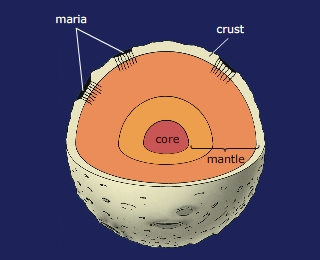 Part A
Part AThe Moon has two distinct types of terrain: the maria and the highlands. On the image of the Moon below, label the specified regions as either maria or highlands.

Part B
The Moon's maria and highlands can be described by the characteristics present in each. Sort the following characteristics by whether they describe the maria or the highlands.

Part C
The relative number of craters found in the maria and the highlands greatly differs. In addition, we have inferred that the maria formed from molten lava welling up from the Moon's mantle. Use this information to rank the following images of lunar regions in order of relative age, from oldest to youngest.

Mercury's Spin-Orbit Resonance
Part A
Compare the magnitude of the Sun's gravitational force on Mercury at locations A, B, and C. (Figure not to scale.)

Part B
In the mid-nineteenth century, astronomers thought that Mercury should be tidally locked to the Sun, meaning it would rotate once for every revolution around the Sun. This scenario would be similar to how the Moon is tidally locked in its orbit around Earth. However in the 1960s, astronomers determined that Mercury is not tidally locked to the Sun. The large eccentricity (exaggerated in the figure) of Mercury's orbit causes large variations in its orbital speed, which prevents tidal locking. Rank the following orbital locations from the fastest orbital speed to the slowest.

Part C
An orbiting body with a tidal bulge, such as Mercury, will try to settle into a synchronous orbit with its partner (in this case, the Sun). However, due to the large eccentricity of Mercury's orbit, the orbital speed at perihelion is very different from the speed at aphelion, making it impossible for Mercury and the Sun to lock in a synchronous orbit. Even though Mercury's orbital speed changes as it travels around the Sun. Mercury's rotation rate and orbital period will synchronize into a simple spin-orbit resonance. Will it synchronize at perihelion or aphelion? (Eccentricity exaggerated for illustration.)
perihelion
The Surface of Mercury
Part A
Though Mercury is a planet orbiting the Sun and the Moon is a natural satellite orbiting Earth, Mercury and the Moon have numerous similarities in appearance. Neither body maintains an atmosphere and both have rocky surfaces that show the marks of their exposed surfaces. Scientists have identified and defined numerous types of surface features. Sort the surface feature terms according to whether they describe features of Mercury, the Moon, or both.
Mercury: scarp & intercrater plains
Moon: mare
Both: crater
Part B
In the image, a scarp known as the Discovery Scarp is shown cutting across several craters. Unlike Earth, Mercury has no plate tectonics or fault lines, so astronomers theorize that the scarp was produced by a process that involved a cooling and contracting of Mercury's surface. Rank the surface features by their relative ages from oldest to youngest.

Process of Science: Formation of the Moon
Part A - Theories of moon formation
Before you can determine which theory best fits the data, you need to define the three theories.

Part B
A theory is a framework of ideas and assumptions used to explain some set of observations and to make predictions about the real world. Each of the three theories for the formation of the Moon lead to different predictions about evidence that we should find. Which of the following predictions should be true if each theory is correct?

Part C
To be effective, a scientific theory must be continually tested. If observations and experiments favor it, a theory can be further developed and refined. If they do not, the theory must be reformulated or rejected. Comparing what you know about the predictions of each Moon formation theory, determine which of the following observations and experiments have been verified.
Earth has a large iron core; the Moon does not.
The mantles of Earth and the Moon have similar compositions.
Computer simulations predict that a collision between Earth and a Mars-sized object would produce a Moon-sized satellite with a stable orbit.
Part D
Based on the evidence for the impact theory, what was the most probable order of events for the collision that led to the formation of the Moon?

The Surface of Mercury Part A answers are wrong....
ReplyDeletethe Scarp and the Crater are in the "both" setion
Deletejk
ReplyDeleteCorrect answers for Theories:
ReplyDelete- Conformation: The moon and earth should (2x)
- Capture: The moon and earth should have different compositions. & Mathematical models.
- Impact: Earth and the Moon. & Computer simulations.
Mercury: intercrater plains
ReplyDeleteMoon: mare
Both: scarp & crater
almost 10 years and this helped me so much today!! thank you
ReplyDeletelife saver
ReplyDeleteYou're the best!
ReplyDelete